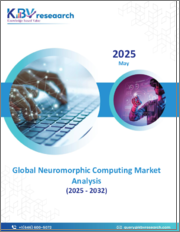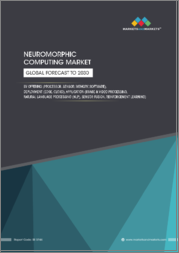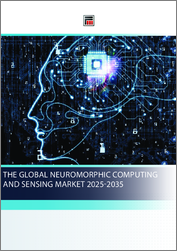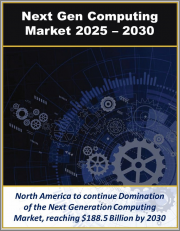
|
시장보고서
상품코드
1614910
뉴로모픽 컴퓨팅 시장 규모, 점유율, 성장 분석 : 컴포넌트별, 도입 방식별, 용도별, 최종 용도별, 지역별 - 산업 예측(2024-2031년)Neuromorphic Computing Market Size, Share, Growth Analysis, By Component (Hardware, Software), By Deployment, By Application, By End Use, By Region - Industry Forecast 2024-2031 |
||||||
세계의 뉴로모픽 컴퓨팅 시장 규모는 2022년에 79억 2,000만 달러에 달하며, 2023년 150억 2,000만 달러에서 2031년에는 2조 5,195억 1,000만 달러로 성장할 것으로 예측되며, 예측 기간(2024-2031년)의 CAGR은 89.7%로 성장할 전망입니다.
세계의 뉴로모픽 컴퓨팅 시장은 인공지능(AI) 및 머신러닝(ML) 기술의 발전으로 인해 큰 성장이 예상되고 있습니다. 뉴로모픽 컴퓨터의 모바일 아키텍처는 컴팩트하고 효율적인 컴퓨팅 솔루션에 대한 수요를 충족시키며, 기존의 부피가 큰 시스템에 비해 공간 활용도를 크게 향상시킵니다. 산업계가 업무 효율성과 제품 품질을 향상시키기 위해 AI와 ML을 점점 더 많이 통합함에 따라 고성능 집적회로(IC)의 필요성이 대두되고 있습니다. 미디어 및 엔터테인먼트, 가전, 항공우주, 유틸리티, 식품 및 음료, 군 등 주요 분야는 특정 과제를 해결하기 위한 솔루션을 적극적으로 찾고 있으며, 이는 뉴로모픽 컴퓨팅에 대한 수요를 더욱 증가시키고 있습니다. 이러한 추세의 수렴으로 뉴로모픽 컴퓨팅 시장은 예측 기간 중 견고한 성장세를 보일 것으로 예상되며, 이는 기술의 미래에 중요한 역할을 반영합니다.
목차
서론
- 분석 목적
- 시장 범위
- 정의
분석 방법
- 정보 조달
- 2차·1차 데이터 방법
- 시장 규모 예측
- 시장의 상정과 제약
개요
- 시장의 개요와 전망
- 수급 동향 분석
- 부문별 기회 분석
시장 역학과 전망
- 시장 개요
- 시장 규모
- 시장 역학
- 촉진요인과 기회
- 억제요인과 과제
- Porter의 산업 분석과 영향
- 경쟁 기업 간 경쟁 관계
- 대체품의 위협
- 바이어의 교섭력
- 신규 진출업체의 위협
- 공급 기업의 교섭력
시장의 주요 인사이트
- 주요 성공 요인
- 경쟁의 정도
- 주요 투자 기회
- 시장 에코시스템
- 시장의 매력 지수(2023년)
- PESTEL 분석
- 거시경제 지표
- 밸류체인 분석
- 가격 분석
- 기술의 진보
- 규제 상황
- 사례 연구
- 고객과 구매 기준 분석
세계의 뉴로모픽 컴퓨팅 시장 규모·CAGR : 컴포넌트별(2024-2031년)
- 시장 개요
- 하드웨어
- 소프트웨어
- 서비스
세계의 뉴로모픽 컴퓨팅 시장 규모·CAGR : 도입 방식별(2024-2031년)
- 시장 개요
- 엣지
- 클라우드
세계의 뉴로모픽 컴퓨팅 시장 규모·CAGR : 용도별(2024-2031년)
- 시장 개요
- 신호 처리
- 영상 처리
- 데이터 처리
- 물체 탐지
- 기타
세계의 뉴로모픽 컴퓨팅 시장 규모·CAGR : 최종 용도별(2024-2031년)
- 시장 개요
- 가전
- 자동차
- 의료
- 군·방위
- 기타
세계의 뉴로모픽 컴퓨팅 시장 규모·CAGR(2024-2031년)
- 북미
- 미국
- 캐나다
- 유럽
- 영국
- 독일
- 스페인
- 프랑스
- 이탈리아
- 기타 유럽 지역
- 아시아태평양
- 중국
- 인도
- 일본
- 한국
- 기타 아시아태평양
- 라틴아메리카
- 브라질
- 기타 라틴아메리카 지역
- 중동 및 아프리카
- GCC 국가
- 남아프리카공화국
- 기타 중동 및 아프리카
경쟁 구도
- 상위 5사의 비교
- 주요 기업의 시장 포지셔닝(2023년)
- 주요 기업이 채택한 전략
- 시장의 최근 동향
- 주요 기업의 시장 점유율(2023년)
- 주요 기업의 개요
- 기업 개요
- 제품 포트폴리오 분석
- 부문별 점유율 분석
- 매출의 전년대비 비교(2021-2023년)
주요 기업 개요
- Intel Corporation
- IBM Corporation
- Samsung Electronics Co., Ltd.
- SK Hynix Inc.
- Qualcomm Technologies, Inc.
- BrainChip Holdings Ltd.
- GrAI Matter Labs
- SynSense AG
- Nepes Corporation
- Vicarious FPC Inc.
- General Vision Inc.
- Prophesee S.A.
- Knowm Inc.
- Hewlett Packard Enterprise(HPE)
- Gyrfalcon Technology Inc.
- TECHiFAB GmbH
- Applied Materials, Inc.
- Micron Technology
- Silicon Storage Technology Inc.
- Brain Corporation
결론과 권장사항
KSA 25.01.03Global Neuromorphic Computing Market size was valued at USD 7.92 Billion in 2022 poised to grow from USD 15.02 Billion in 2023 to USD 2,519.51 Billion by 2031, growing at a CAGR of 89.7% in the forecast period (2024-2031).
The global neuromorphic computing market is poised for significant growth, driven by advancements in artificial intelligence (AI) and machine learning (ML) technologies. The mobile architecture of neuromorphic computers addresses the demand for compact, efficient computing solutions, significantly enhancing space utilization compared to traditional bulky systems. As industries increasingly integrate AI and ML to improve operational efficiency and product quality, the need for high-performance integrated circuits (ICs) emerges. Key sectors such as media and entertainment, consumer electronics, aerospace, utilities, food and beverage, and military are actively seeking solutions to address specific challenges, further escalating the demand for neuromorphic computing. This convergence of trends positions the neuromorphic computing market for robust expansion throughout the forecast period, reflecting its critical role in the future of technology.
Top-down and bottom-up approaches were used to estimate and validate the size of the Global Neuromorphic Computing market and to estimate the size of various other dependent submarkets. The research methodology used to estimate the market size includes the following details: The key players in the market were identified through secondary research, and their market shares in the respective regions were determined through primary and secondary research. This entire procedure includes the study of the annual and financial reports of the top market players and extensive interviews for key insights from industry leaders such as CEOs, VPs, directors, and marketing executives. All percentage shares split, and breakdowns were determined using secondary sources and verified through Primary sources. All possible parameters that affect the markets covered in this research study have been accounted for, viewed in extensive detail, verified through primary research, and analyzed to get the final quantitative and qualitative data.
Global Neuromorphic Computing Market Segmental Analysis
Global Neuromorphic Computing Market is segmented by Component, Deployment, Application, End Use and region. Based on Component, the market is segmented into Hardware, Software, Services. Based on Deployment, the market is segmented into Edge, Cloud. Based on Application, the market is segmented into Signal Processing, Image Processing, Data Processing, Object Detection, Others. Based on End Use, the market is segmented into Consumer Electronics, Automotive, Healthcare, Military & Defense, Others. Based on region, the market is segmented into North America, Europe, Asia Pacific, Latin America and Middle East & Africa.
Driver of the Global Neuromorphic Computing Market
The global neuromorphic computing market is primarily driven by the escalating demand for energy-efficient artificial intelligence solutions. As industries seek to overcome the energy constraints associated with traditional mechanical intelligence technologies, neuromorphic systems offer a compelling alternative by emulating the brain's low-power processing. These advanced systems are particularly beneficial for applications like robotics and autonomous vehicles, where conventional hardware struggles with high power consumption and the need for real-time responsiveness. By providing a sustainable computing paradigm, neuromorphic computing addresses the critical limitations of existing solutions, positioning itself as an essential driver of innovation in the realm of AI technologies.
Restraints in the Global Neuromorphic Computing Market
The Global Neuromorphic Computing market faces significant restraints, particularly in the areas of standardization and development. The lack of uniform programming frameworks and tools tailored for neuromorphic systems creates obstacles for developers accustomed to conventional architectures. This mismatch necessitates the use of unconventional programming paradigms, complicating the coding process and hindering progress. Consequently, the absence of adequate tools and standard practices impedes the speed of development and integration, which ultimately restricts the widespread adoption of neuromorphic computing across various sectors and applications. Efforts to address these challenges are essential for advancing the technology's integration into mainstream use.
Market Trends of the Global Neuromorphic Computing Market
The global neuromorphic computing market is witnessing a significant trend towards the integration of edge computing technologies, enhancing the capabilities of neuromorphic systems. This shift enables near-instantaneous data processing and real-time decision-making, critical for applications in the Internet of Things (IoT), autonomous vehicles, and robotics. By processing data directly at the edge, organizations can reduce latency, improve efficiency, and boost overall productivity, positioning neuromorphic computing as a vital component in the evolution of smart systems. This trend reflects a broader movement towards decentralized computing architectures that cater to the increasing demand for swift and intelligent responses in dynamic environments.
Table of Contents
Introduction
- Objectives of the Study
- Scope of the Report
- Definitions
Research Methodology
- Information Procurement
- Secondary & Primary Data Methods
- Market Size Estimation
- Market Assumptions & Limitations
Executive Summary
- Global Market Outlook
- Supply & Demand Trend Analysis
- Segmental Opportunity Analysis
Market Dynamics & Outlook
- Market Overview
- Market Size
- Market Dynamics
- Driver & Opportunities
- Restraints & Challenges
- Porters Analysis & Impact
- Competitive rivalry
- Threat of substitute
- Bargaining power of buyers
- Threat of new entrants
- Bargaining power of suppliers
Key Market Insights
- Key Success Factors
- Degree of Competition
- Top Investment Pockets
- Market Ecosystem
- Market Attractiveness Index, 2023
- PESTEL Analysis
- Macro-Economic Indicators
- Value Chain Analysis
- Pricing Analysis
- Technological Advancement
- Regulatory Landscape
- Case Studies
- Customer & Buying Criteria Analysis
Global Neuromorphic Computing Market Size by Component & CAGR (2024-2031)
- Market Overview
- Hardware
- Software
- Services
Global Neuromorphic Computing Market Size by Deployment & CAGR (2024-2031)
- Market Overview
- Edge
- Cloud
Global Neuromorphic Computing Market Size by Application & CAGR (2024-2031)
- Market Overview
- Signal Processing
- Image Processing
- Data Processing
- Object Detection
- Others
Global Neuromorphic Computing Market Size by End Use & CAGR (2024-2031)
- Market Overview
- Consumer Electronics
- Automotive
- Healthcare
- Military & Defense
- Others
Global Neuromorphic Computing Market Size & CAGR (2024-2031)
- North America (Component, Deployment, Application, End Use)
- US
- Canada
- Europe (Component, Deployment, Application, End Use)
- UK
- Germany
- Spain
- France
- Italy
- Rest of Europe
- Asia-Pacific (Component, Deployment, Application, End Use)
- China
- India
- Japan
- South Korea
- Rest of Asia Pacific
- Latin America (Component, Deployment, Application, End Use)
- Brazil
- Rest of Latin America
- Middle East & Africa (Component, Deployment, Application, End Use)
- GCC Countries
- South Africa
- Rest of Middle East & Africa
Competitive Intelligence
- Top 5 Player Comparison
- Market Positioning of Key Players, 2023
- Strategies Adopted by Key Market Players
- Recent Developments in the Market
- Company Market Share Analysis, 2023
- Company Profiles of All Key Players
- Company Details
- Product Portfolio Analysis
- Company's Segmental Share Analysis
- Revenue Y-O-Y Comparison (2021-2023)
Key Company Profiles
- Intel Corporation
- Company Overview
- Business Segment Overview
- Financial Updates
- Key Developments
- IBM Corporation
- Company Overview
- Business Segment Overview
- Financial Updates
- Key Developments
- Samsung Electronics Co., Ltd.
- Company Overview
- Business Segment Overview
- Financial Updates
- Key Developments
- SK Hynix Inc.
- Company Overview
- Business Segment Overview
- Financial Updates
- Key Developments
- Qualcomm Technologies, Inc.
- Company Overview
- Business Segment Overview
- Financial Updates
- Key Developments
- BrainChip Holdings Ltd.
- Company Overview
- Business Segment Overview
- Financial Updates
- Key Developments
- GrAI Matter Labs
- Company Overview
- Business Segment Overview
- Financial Updates
- Key Developments
- SynSense AG
- Company Overview
- Business Segment Overview
- Financial Updates
- Key Developments
- Nepes Corporation
- Company Overview
- Business Segment Overview
- Financial Updates
- Key Developments
- Vicarious FPC Inc.
- Company Overview
- Business Segment Overview
- Financial Updates
- Key Developments
- General Vision Inc.
- Company Overview
- Business Segment Overview
- Financial Updates
- Key Developments
- Prophesee S.A.
- Company Overview
- Business Segment Overview
- Financial Updates
- Key Developments
- Knowm Inc.
- Company Overview
- Business Segment Overview
- Financial Updates
- Key Developments
- Hewlett Packard Enterprise (HPE)
- Company Overview
- Business Segment Overview
- Financial Updates
- Key Developments
- Gyrfalcon Technology Inc.
- Company Overview
- Business Segment Overview
- Financial Updates
- Key Developments
- TECHiFAB GmbH
- Company Overview
- Business Segment Overview
- Financial Updates
- Key Developments
- Applied Materials, Inc.
- Company Overview
- Business Segment Overview
- Financial Updates
- Key Developments
- Micron Technology
- Company Overview
- Business Segment Overview
- Financial Updates
- Key Developments
- Silicon Storage Technology Inc.
- Company Overview
- Business Segment Overview
- Financial Updates
- Key Developments
- Brain Corporation
- Company Overview
- Business Segment Overview
- Financial Updates
- Key Developments



















